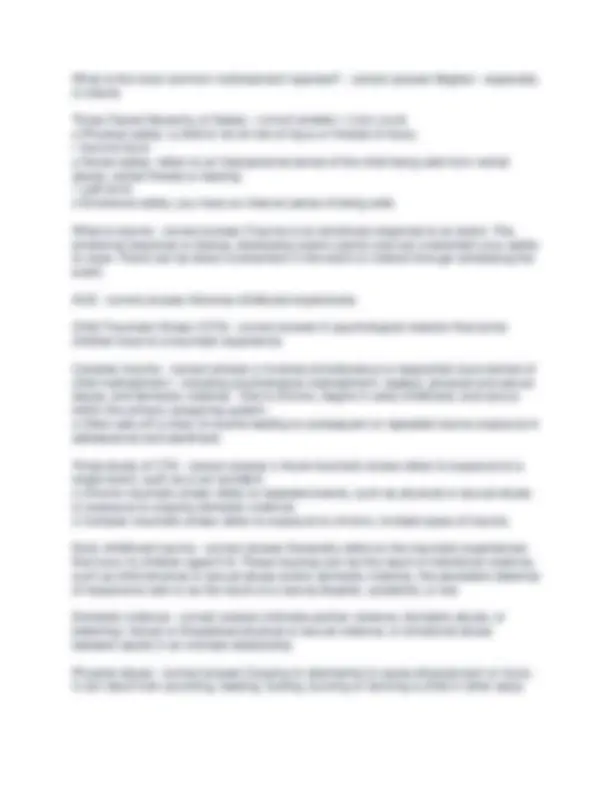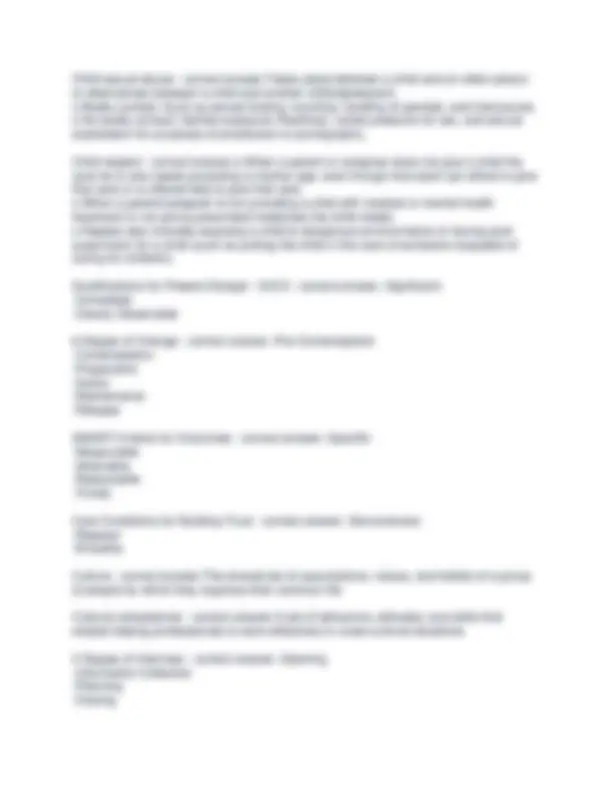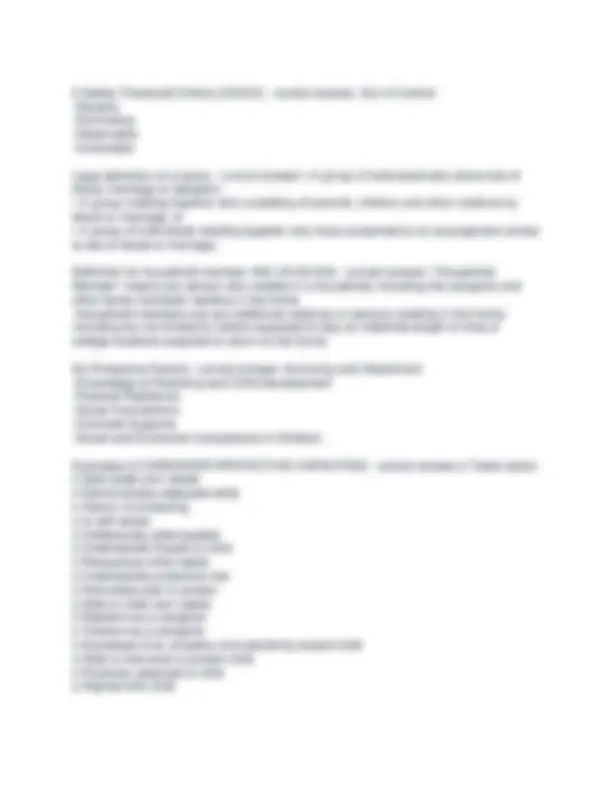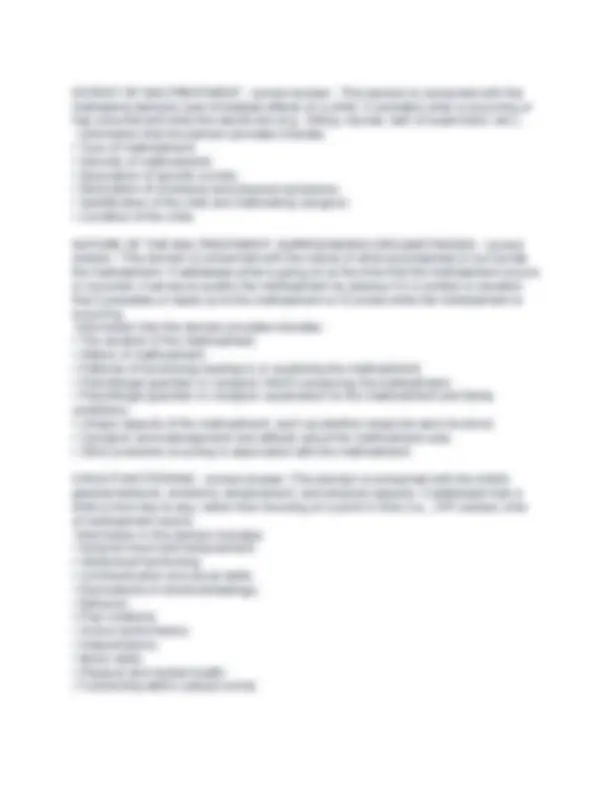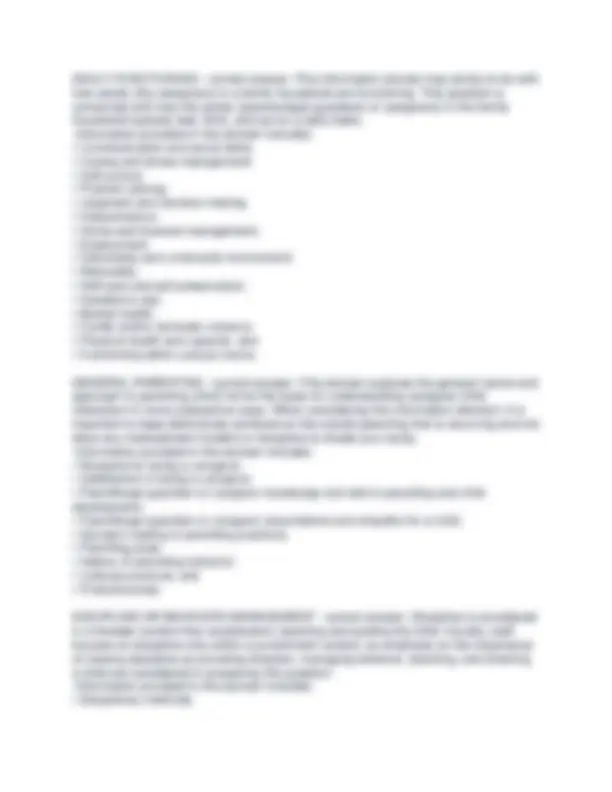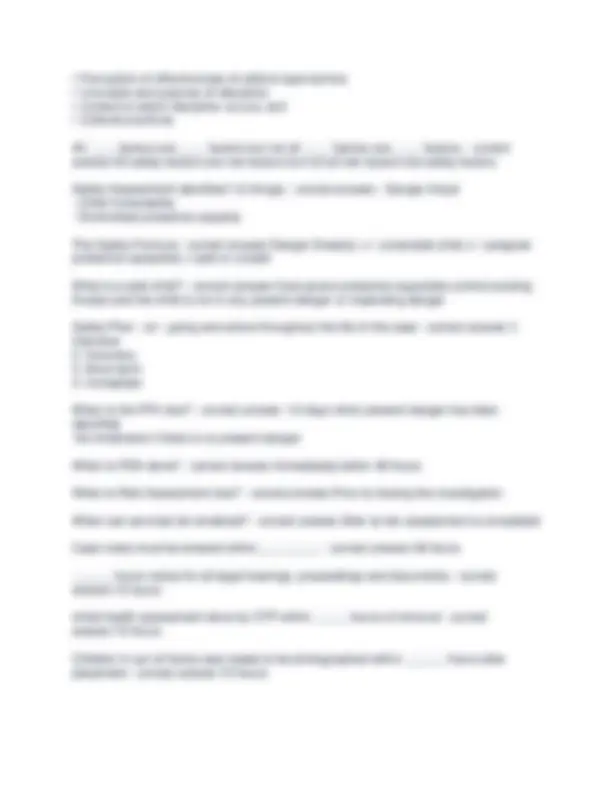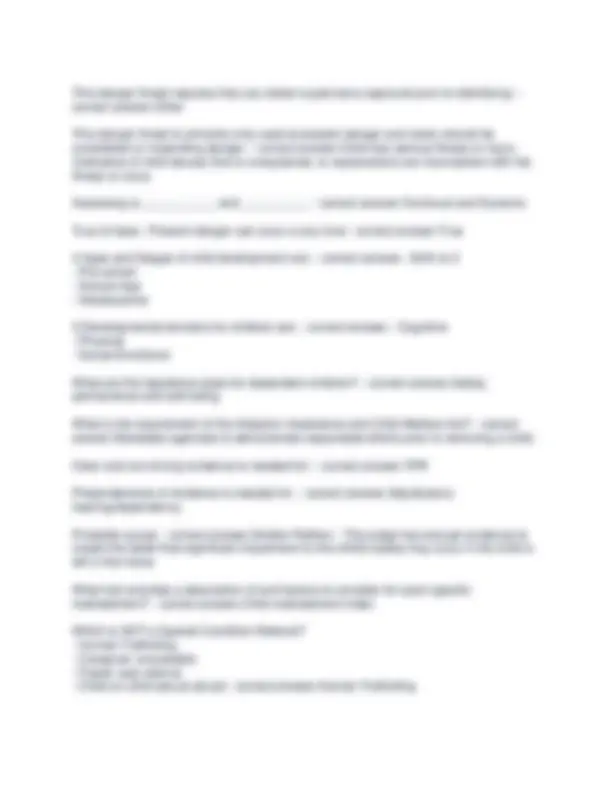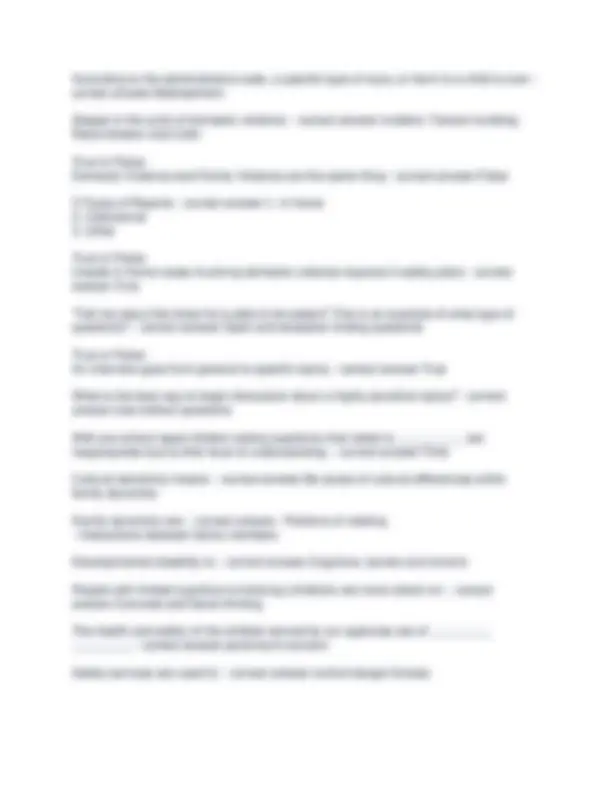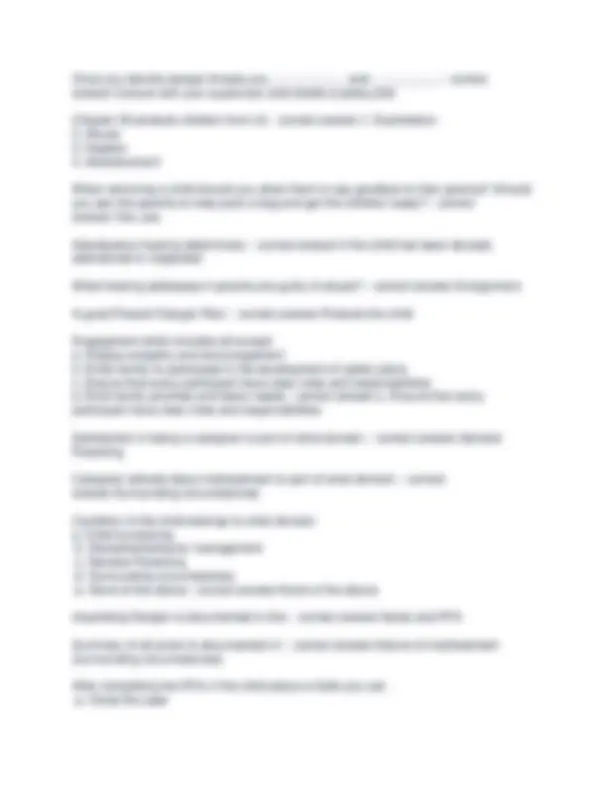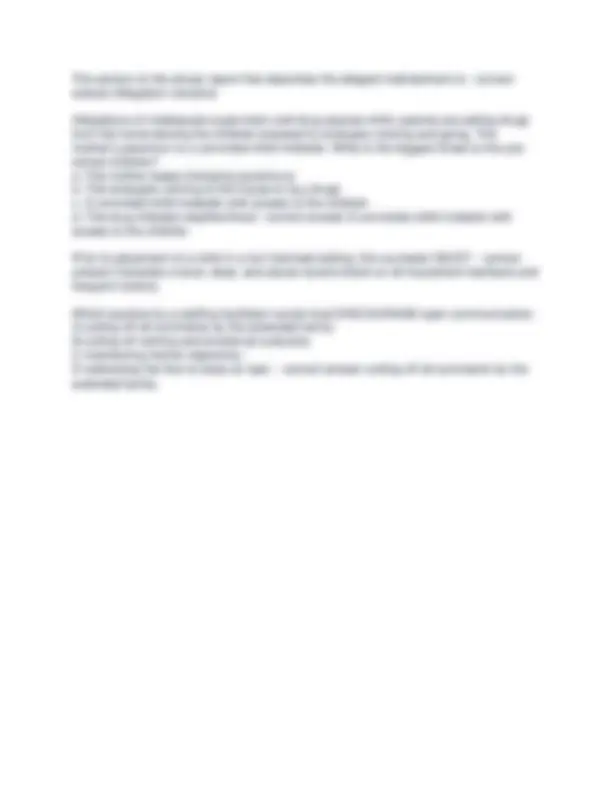Download Child Welfare Certification Exam With Complete Solutions 2024 and more Exams Integrated Case Studies in PDF only on Docsity!
Child Welfare Certification Exam With
Complete Solutions 2024
Dependency Petition - correct answer.Court ordered services due to no change in action or child's safety is at risk Shelter Petition - correct answer.Attempt to remove child from care giver and be placed elsewhere ASFA-Adoption and Safe Family Act of 1997 - correct answer.Reach permanency within 1 year from removal ICWA-Indian Child Welfare Act - correct answer.If family is a part of an Indian tribe then CPI will have to get with legal to see if the tribe will handle the allegations of if CPI will move forward with the investigation MEPA-Multi Ethnic Placement Act - correct answer.This act does not allow a child to be held back from placement or permanency based on the child's race, gender, religion etc. 4 Work Principles-Principle 1 - correct answer.The health and safety of the child is the top priority 4 Work Principles-Principle 2 - correct answer.Work as partners with the families: Respect them, engage them etc. 4 Work Principles-Principle 3 - correct answer.Always begin with the least intrusive actions that are possible and reasonable. Be objective and keep the child's safety in the forefront of your mind 4 Work Principles-Principle 4 - correct answer.Prevention and intervention should result in protecting children and supporting families Practice Model - correct answer.1. Hotline
- CPI FFA
- Ongoing Family Functioning
- Safety plan and case plan evaluation
- Anticipated intervention FFA-6 Domains - correct answer.1. Maltreatment
- Circumstances surrounding the circumstances
- Child functioning
- Adult Functioning
- General Parenting
- Parent Discipline Approach Least Intrusive - correct answer.The combination of interventions that will be the most effective, cause the least disruption to the child and family's normal routines and will e aligned to the fullest extent feasible with the family's references, culture and values Caregiver Protective Capacities - correct answer.The personal and caregiving behavioral, cognitive and emotional characteristics that specifically and directly can be associated with being protective to one's children. When the caregivers responsible are able to effectively manage negative family conditions in the home for the long term, the child is safe. Protective capacities are personal qualities or characteristics that contribute to vigilant child protection 3 Protective Capacity Areas - correct answer.1. Cognitive
- Behavioral
- Emotional Legal definition of the term child - correct answer.Chapter 39, Florida Statutes: o "any unmarried person under the age of 18 years who has not been emancipated by order of the court" o The terms child and youth are interchangeable Present Danger - correct answer.Usually identified at initial contact, however can occur during the course of an investigation or while the family is receiving case management services. Serious harm will result without prompt investigation and/or case manager response Define Impending Danger - correct answer.• Child living or being in a position of continual or pervasive danger.
- Threats are not immediate, obvious or active at the onset of investigation.
- Are identified and understood upon gathering sufficient family functioning information. Factors of Impending Danger - correct answer.1. Imminent
- Out of Control
- Vulnerable Child
- Observable
- Severity
Child sexual abuse - correct answer.Takes place between a child and an older person or alternatively between a child and another child/adolescent. o Bodily contact: Such as sexual kissing, touching, fondling of genitals, and intercourse. o No bodily contact: Genital exposure ('flashing'), verbal pressure for sex, and sexual exploitation for purposes of prostitution or pornography. Child neglect - correct answer.o When a parent or caregiver does not give a child the care he or she needs according to his/her age, even though that adult can afford to give that care or is offered help to give that care. o When a parent/caregiver is not providing a child with medical or mental health treatment or not giving prescribed medicines the child needs. o Neglect also includes exposing a child to dangerous environments or having poor supervision for a child (such as putting the child in the care of someone incapable of caring for children). Qualifications for Present Danger - SICO - correct answer.-Significant
- Immediate
- Clearly Observable 6 Stages of Change - correct answer.-Pre-Contemplation
- Contemplation
- Preparation
- Action
- Maintenance
- Relapse SMART Criteria for Outcomes - correct answer.-Specific
- Measurable
- Attainable
- Reasonable
- Timely Core Conditions for Building Trust - correct answer.-Genuineness
- Respect
- Empathy Culture - correct answer.The shared set of assumptions, values, and beliefs of a group of people by which they organize their common life Cultural competence - correct answer.A set of behaviors, attitudes, and skills that enable helping professionals to work effectively in cross-cultural situations 4 Stages of Interview - correct answer.-Opening
- Information Collection
- Planning
- Closing
5 Safety Threshold Criteria (OOSIV) - correct answer.-Out of Control
- Severity
- Imminence
- Observable
- Vulnerable Legal definition of a family - correct answer.• A group of individuals who share ties of blood, marriage or adoption;
- A group residing together and consisting of parents, children and other relatives by blood or marriage; or
- A group of individuals residing together who have consented to an arrangement similar to ties of blood or marriage. Definition for household member: 65C-30.001(64) - correct answer.-"Household Member" means any person who resides in a household, including the caregiver and other family members residing in the home
- Household members are any additional relatives or persons residing in the home, including but not limited to visitors expected to stay an indefinite length of time or college students expected to return to the home. Six Protective Factors - correct answer.-Nurturing and Attachment
- Knowledge of Parenting and Child Development
- Parental Resilience
- Social Connections
- Concrete Supports
- Social and Emotional Competence of Children Examples of CAREGIVER PROTECTIVE CAPACITIES - correct answer.o Takes action o Sets aside own needs o Demonstrates adequate skills o History of protecting o Is self-aware o Intellectually able/capable o Understands threats to child o Recognizes child needs o Understands protective role o Articulates plan to protect o Able to meet own needs o Resilient as a caregiver o Tolerant as a caregiver o Expresses love, empathy and sensitivity toward child o Able to intervene to protect child o Positively attached to child o Aligned with child
omissions. Corporal discipline of a child by a parent or legal custodian for disciplinary purposes does not in itself constitute abuse when it does not result in harm to the child Neglect - correct answer.When a child is deprived of or is allowed to be deprived of necessary food, clothing, shelter or medical treatment, or a child is permitted to live in a n environment when such deprivation or environment causes the child's physical, mental or emotional health to be significantly impaired or to be in danger of being significantly impaired Findings - Verified - correct answer.Is used when a preponderance of the credible evidence results in a determination the specific harm or threat of harm was the result of abuse, abandonment or neglect Findings - Not Substantiated - correct answer.Used when there is credible evidence which does not meet the standard of being a preponderance to support that the specific harm of threat of harm was the result of abuse, abandonment or neglect Findings - No Indicator - correct answer.Used when there is no credible evidence to support that the specific harm was the result of abuse, abandonment or neglect 4 Special Condition Cases - correct answer.1. Caregiver Unavailable
- Child on Child Sexual Abuse
- Foster Care Referral
- Parent Needs Assistance What do you need to verify a case? - correct answer.A PREPONDERENCE OF THE CREDIBLE EVIDENCE results in a determination that the specific harm or threat of harm was the result of abuse, abandonment or neglect of the credible evidence results in a determination that the specific harm or threat of harm was the result of abuse, abandonment or neglect Preponderance of Evidence - correct answer.The greater weight of the evidence, or more likely than not to have occurred What is the purpose of the FFA? - correct answer.Did the reported incident happen to the child and is the child living in a state of danger that requires our intervention. What children/cases will be transferred to case management? - correct answer.Only unsafe children that are in a state of danger will be transferred to case management. According to Chapter 39 the CPI has X amount of days to gather all of the required information to asses that family and close their case? - correct answer.60 Days according you Chapter 39 BUT DCF likes that case to be closed within 45 You will document IMPENDNG DANGER in your ________ and in your ________. - correct answer.Notes/FFA
EXTENT OF MALTREATMENT - correct answer.- This domain is concerned with the maltreating behavior and immediate effects on a child. It considers what is occurring or has occurred and what the results are (e.g., hitting, injuries, lack of supervision, etc.).
- Information that this domain provides includes:
- Type of maltreatment;
- Severity of maltreatment;
- Description of specific events;
- Description of emotional and physical symptoms;
- Identification of the child and maltreating caregiver;
- Condition of the child. NATURE OF THE MALTREATMENT: SURROUNDING CIRCUMSTANCES - correct answer.- This domain is concerned with the nature of what accompanies or surrounds the maltreatment. It addresses what is going on at the time that the maltreatment occurs or occurred. It serves to qualify the maltreatment by placing it in a context or situation that l) precedes or leads up to the maltreatment or 2) exists while the maltreatment is occurring.
- Information that this domain provides includes:
- The duration of the maltreatment;
- History of maltreatment;
- Patterns of functioning leading to or explaining the maltreatment;
- Parent/legal guardian or caregiver intent concerning the maltreatment;
- Parent/legal guardian or caregiver explanation for the maltreatment and family conditions;
- Unique aspects of the maltreatment, such as whether weapons were involved;
- Caregiver acknowledgement and attitude about the maltreatment and;
- Other problems occurring in association with the maltreatment. CHILD FUNCTIONING - correct answer.-This domain is concerned with the child's general behavior, emotions, temperament, and physical capacity. It addresses how a child is from day to day, rather than focusing on a point in time (i.e.,, CPI contact, time of maltreatment event).
- Information in this domain includes:
- General mood and temperament;
- Intellectual functioning;
- Communication and social skills;
- Expressions of emotions/feelings;
- Behavior;
- Peer relations;
- School performance;
- Independence;
- Motor skills;
- Physical and mental health;
- Functioning within cultural norms.
- Perception of effectiveness of utilized approaches;
- Concepts and purpose of discipline;
- Context in which discipline occurs; and
- Cultural practices. All ____ factors are ____ factors but not all ____ factors are ____ factors. - correct answer.All safety factors are risk factors but not all risk factors are safety factors Safety Assessment identifies? (3 things) - correct answer.- Danger threat
- Child Vulnerability
- Diminished protective capacity The Safety Formula - correct answer.Danger threat(s) +/- vulnerable child +/- caregiver protective capacities = safe or unsafe What is a safe child? - correct answer.Care givers protective capacities control existing threats and the child is not in any present danger or impending danger Safety Plan - on - going and active throughout the life of the case - correct answer.1. Intensive
- Voluntary
- Short-term
- Immediate When is the FFA due? - correct answer.-14 days when present danger has been identified
- No timeframe if there is no present danger When is PDA done? - correct answer.Immediately/within 48 hours When is Risk Assessment due? - correct answer.Prior to closing the investigation When can services be rendered? - correct answer.After at risk assessment is completed Case notes must be entered within_________. - correct answer.48 hours ______ hours notice for all legal hearings, proceedings and documents - correct answer.72 hours Initial health assessment done by CTP within _____ hours of removal - correct answer.72 hours Children in out-of-home care needs to be photographed within ______ hours after placement - correct answer.72 hours
Once in shelter status, the child needs to be seen once every ____ days - correct answer.7 days Once a dependency is established, the child needs to be seen once every ______ days
- correct answer.30 days Case plan ____ days from removal - correct answer.60 days Mandatory CPT - correct answer.1. Child of any age with injuries on the head or neck, burns or fractures
- Child 5 years or younger injuries
- Sexual abuse with alleged or allegation (stated as fact) of penetration
- Sexually transmitted disease of a prepubescent child
- Medical neglect
- Serious emotional problems
- In home sibling of child or children who have been pronounced as dead as a result of abuse, abandonment or neglect Case needs to be commenced within _____ hours unless it is immediate then case should be commenced within ____ hours but no more than _____ hours - correct answer.24 hours, 2 hours, 4 hours Order of Interview: - correct answer.1. Child Victim(s)
- Siblings or other children in the household
- Non-offending caregiver or parent
- Alleged caregiver or parent
- Collateral contacts that are likely to provide credible evidence or critical information 5 Steps of the Interview - correct answer.1. Preparation
- Engagement
- Interview
- Closure
- Document Placement Priority - correct answer.1. Non-Custodial caregiver
- Relative
- Non relative
- Licensing/Foster/Home
- Medical Foster Home
- Residential Group Home
- Treatment Facility Words that describe present danger - correct answer.Situational and Occurring Words that describe impending danger - correct answer.Pervasive state of danger
This danger threat requires that you obtain supervisory approval prior to identifying: - correct answer.Other This danger threat is primarily only used at present danger and rarely should be considered or impending danger: - correct answer.Child has serious illness or injury (indicative of child abuse) that is unexplained, or explanations are inconsistent with the illness or injury Assessing is ___________ and __________ - correct answer.Continual and Dynamic True of false - Present danger can occur a any time - correct answer.True 4 Ages and Stages of child development are: - correct answer.- Birth to 3
- Pre-school
- School Age
- Adolescence 3 Developmental domains for children are: - correct answer.- Cognitive
- Physical
- Social-Emotional What are the legislative goals for dependent children? - correct answer.Safety, permanence and well-being What is the requirement of the Adoption Assistance and Child Welfare Act? - correct answer.Mandates agencies to demonstrate reasonable efforts prior to removing a child. Clear and convincing evidence is needed for: - correct answer.TPR Preponderance of evidence is needed for: - correct answer.Adjudicatory hearing/dependency Probable cause: - correct answer.Shelter Petition - The judge has enough evidence to create the belief that significant impairment to the child's safety may occur if the child is left in the home What tool provides a description of and factors to consider for each specific maltreatment? - correct answer.Child maltreatment index Which is NOT a Special Condition Referral?
- Human Trafficking
- Caregiver unavailable
- Foster care referral
- Child on child sexual abuse - correct answer.Human Trafficking
According to the administrative code, a specific type of injury or harm to a child is a/an - correct answer.Maltreatment Stages in the cycle of domestic violence: - correct answer.Incident, Tension building, Reconciliation and Calm True or False: Domestic Violence and Family Violence are the same thing - correct answer.False 3 Types of Reports - correct answer.1. In-home
- Institutional
- Other True or False: Unsafe in-home cases involving domestic violence requires 2 safety plans - correct answer.True "Tell me about the times he is able to be patient" This is an example of what type of questions? - correct answer.Open and exception finding questions True or False: An interview goes from general to specific topics - correct answer.True What is the best way to begin discussion about a highly sensitive topics? - correct answer.Use indirect questions With pre-school aged children asking questions that relate to __________ are inappropriate due to their level of understanding. - correct answer.Time Cultural sensitivity means: - correct answer.Be aware of cultural differences within family dynamics Family dynamics are: - correct answer.- Patterns of relating
- Interactions between family members Developmental disability is: - correct answer.Cognitive, severe and chronic People with limited cognitive functioning (children) are more reliant on: - correct answer.Concrete and literal thinking The health and safety of the children served by our agencies are of _________ _________ - correct answer.paramount concern Safety services are used to: - correct answer.control danger threats
b. Refer family to Diversion (community services) if necessary c. Do a preventive Safety plan d. A and B are correct - correct answer.A and B are correct Crisis Intervention Services are to be provided: - correct answer.As part of the impending danger plan Treatment Services are provided when: - correct answer.The case goes to Case Management Org.
- Essential skill: Assessment and Understanding includes: a. Learn about the cultural influences b. Making sure we understand the reason for the abuse c. Identify resources d. The use of active listening - correct answer.Learn about the cultural influences Contact LE prior to commencement when: - correct answer.Allegations are confirmed criminal On child on child reports is more important to determine: a. Where the offender learn the behavior b. If the parents believe the abuse c. If the children go to the same school d. Victim vulnerability - correct answer.Victim vulnerability The hearing where parents can offer testimony is: - correct answer.Adjudicatory One responsibility of the CPI is to a. Investigate supplemental reports to the hotline b. Document the findings of the investigation in the FFA c. Determine what service the family needs d. Do an on-going FFA before closing the investigation - correct answer.Document the findings of the investigation in the FFA Standards of Proof in the dependency courts are: (3) - correct answer.Probable cause, preponderance of the evidence and clear and convincing Types of Petitions that can be filed in court are: (3) - correct answer.Dependency, TPR, Shelter What information CLS needs regarding possible witness: - correct answer.Name, type of testimony the can provide Which of the following is at the BOTTOM of the legal hierarchy? a. Administrative rules b. Federal statutes
c. Operating procedures d. State statutes - correct answer.Operating procedures 64 Which of the following explains the purposes and requirements for juvenile court hearings? a. Juvenile administrative codes b. Florida Rules of Juvenile Procedure c. Operating procedures for juveniles d. State statutes - correct answer.Florida Rules of Juvenile Procedure Petitions are of paramount importance in dependency cases because: - correct answer.States the allegations of abuse, neglect, abandonment Evidence is : - correct answer.Anything that helps prove or disprove the allegations
- When in shelter status the child must be seen once every______ _________. - correct answer.7 days Before releasing reporter's name we need: - correct answer.written permission from the reporter
- The court relies upon the Judicial Review Social Summary Report to explain: - correct answer.the degree of progress made toward the permanency goal. Gather, document, assess, and make decision are steps in which of the following processes? (GDAM) - correct answer.Decision Making A crucial requirement for eligibility in the relative caregiver program is that the child: - correct answer.Has been ruled dependent. The caller ID for the reporter can be use when: - correct answer.- child is a caller
- self-reporting.
- if the family location is unknown Dependency cases are handled in the - correct answer.Juvenile Court The Uniform Child Custody Jurisdiction and Enforcement Act (UCCJEA) determines: - correct answer.Which State/County has jurisdiction If the child is removed who has priority when placing the child: - correct answer.The non-custodial parent A child health check must be completed within how many hours of removal: - correct answer.72 hours

